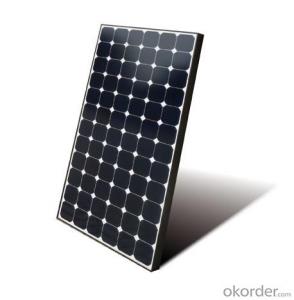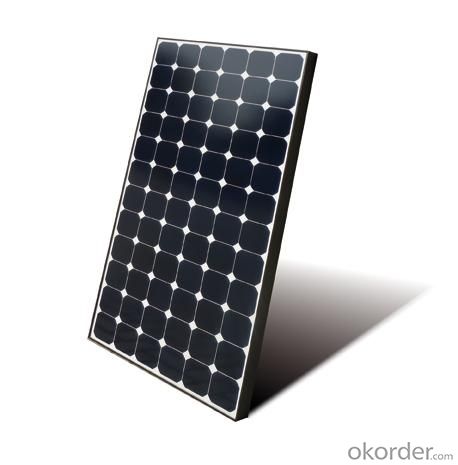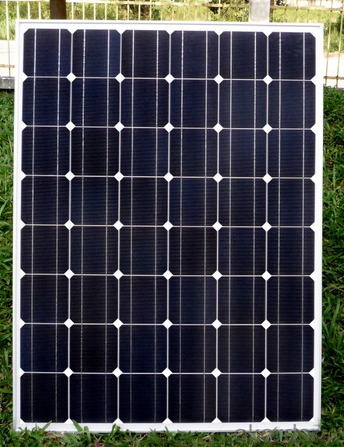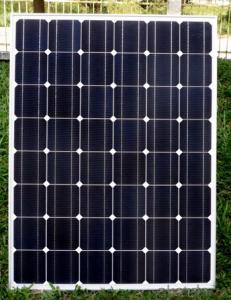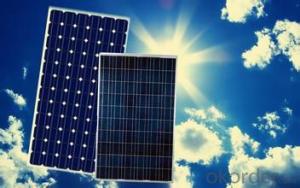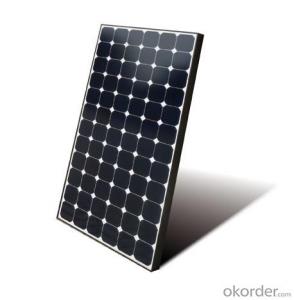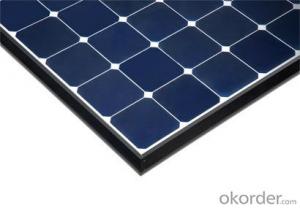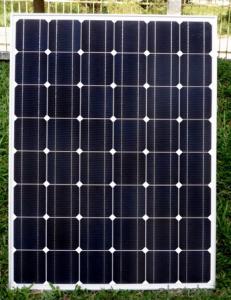Q Solar Panels Mono Solar Panel 65w A Grade with Cheapest Price
- Loading Port:
- Tianjin
- Payment Terms:
- TT OR LC
- Min Order Qty:
- 100 watt
- Supply Capability:
- 1000 watt/month
OKorder Service Pledge
OKorder Financial Service
You Might Also Like
Specification
Mono Solar Panel 65W A Grade with Cheapest Price
product description
Strings of series cells are usually handled independently and not connected in parallel, though as of 2014)individual power boxes are often supplied for each module, and are connected in parallel. Although modules can be interconnected to create an array with the desired peak DC voltage and loading current capacity, using independent MPPTs (maximum power point trackers) is preferable. Otherwise, shunt diodes can reduce shadowing power loss in arrays with series/parallel connected cells.[citation needed]
The photovoltaic effect was experimentally demonstrated first by French physicist Edmond Becquerel. In 1839, at age 19, he built the world's first photovoltaic cell in his father's laboratory. Willoughby Smith first described the "Effect of Light on Selenium during the passage of an Electric Current" in a 20 February 1873 issue of Nature. In 1883 Charles Fritts built the first solid statephotovoltaic cell by coating the semiconductor selenium with a thin layer of gold to form the junctions; the device was only around 1% efficient.
A photovoltaic (in short PV) module is a packaged, connected assembly of typically 6×10 solar cells. Solar Photovoltaic panels constitute the solar array of a photovoltaic system that generates and supplies solar electricity in commercial and residential applications. Each module is rated by its DC output power under standard test conditions, and typically ranges from 100 to 365 watts. The efficiency of a module determines the area of a module given the same rated output – an 8% efficient 230 watt module will have twice the area of a 16% efficient 230 watt module. There are a few solar panels available that are exceeding 19% efficiency. A single solar module can produce only a limited amount of power; most installations contain multiple modules. A photovoltaic system typically includes a panel or an array of solar modules, a solar inverter, and sometimes a battery and/or solar tracker and interconnection wiring.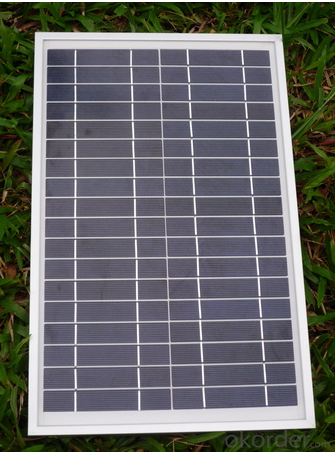
Feature
The modules use high-quality imported polycrystalline or Polycrystalline solar panel;
Enclosed by high-rigidity tempered glass, with excellent light transmittance and output performance;
Surface treated with reflection-reducing process, increasing the light absorption.
Back sealed with anti-aging EVA, resistant from moisture and corrosion.
The efficiency of our Polycrystalline solar cell is over 17%, and polycrystalline panel is over 16%. We stipulate, the allowance of each panel’s rated power has to be positive. Each panel is strictly tested before leaving the factory.
Our solar panel is designed with a lifetime of 25 years, and guaranteed that the power decline less than 10% within 10 years, and 20% within 20 years.
Packaging
28pcs into one box 48pcs into one pallet.
Delivery
20 days after received full payment
Payment term
LC&TT
- Q: Can solar panels be installed on the ground?
- Yes, solar panels can be installed on the ground. Ground-mounted solar panels are a popular option for residential, commercial, and utility-scale solar installations. They are typically mounted on racks or frames that are secured to the ground, allowing the panels to capture sunlight and convert it into electricity. Ground-mounted solar panels are often preferred when there is limited roof space or for installations that require optimal positioning and easy maintenance.
- Q: My house uses 500 kw a month, air conditioning is the main consumer, is it possible to install solar panels in my roof to produce this amount, and aproximate cost, thanks .
- There okorder / Why pay thousands of dollars for solar energy ($27,000 average cost) when you can build your own solar panel system for just a fraction of the retail cost. You can build a single solar panel or you can build an entire array of panels to power your whole house. Some people are saving 50% on their power bill, some people are reducing their bill to nothing. But what’s most impressive is that just by following these instructions some are even making the power company pay them!
- Q: is a wind turbine better than solar panels
- Both solar and wind production is largely a function of location. If you live in the southwest where the sun shines most days, maybe solar is an option. If you happen to live in one of the wind corridors, maybe wind is an option. Neither one will be as reliable and cheap as your grid power, though. Best is to concentrate on conservation of energy use.
- Q: I am working on a project and I have to build a house with solar panels. My teacher asked me how would I get solar energy if it is rainy or cloudy? I looked it up but didn't understand. Please help me!!
- You okorder /
- Q: if so, would it be possible to make (or remake) an organism that could subsist off of sunlight and external heat like plants?
- There are, in fact, protozoa that use chlorophyll to harvest sunlight, but the thing is, they also MOVE. So it's not entirely unreasonable that an animal cell could do the same.
- Q: im interested in starting a solar panel manufacturing company. ive researched on how to make them and it doesnt look too hard, and is definitely something i can figure out. i would be starting from nothing so my question is what are the chances of me actually selling a lot of panels and the business actually succeding?thanks
- At this very moment, most of the people already have an idea on how to create their own solar panels, And creating your own company takes a lot of necessities such as permits ans other stuffs like that,.
- Q: Why are they placed there? How come they aren't placed on the floor or window.My fiance and I are interested in putting solar panels on our new home. I was really curious and google wasn't giving me the answer. My roof is pretty small in our new house and I don't think it would fit there. Why is it usually placed there and is there another place? You will be chosen as best answer if you answer all my questions. Thanks in advance, and I would appreciate if nobody is rude. Otherwise, I will have to report abuse.
- In most cases the roof gets the most exposure to the sun. However Panels can be mounted in the yard on platforms that follows the Sun's movement. One must take into consideration of where the panels will get the most exposure to the sun.
- Q: Can solar panels be used for powering a museum or cultural institution?
- Yes, solar panels can certainly be used to power a museum or cultural institution. Solar panels generate electricity by converting sunlight into energy, and this renewable energy source can effectively meet the power needs of such establishments. By installing solar panels on the building's roof or in nearby open spaces, museums and cultural institutions can reduce their dependence on traditional energy sources, lower their carbon footprint, and potentially even generate excess electricity that can be fed back into the grid. Additionally, embracing solar power aligns with the sustainable and environmentally conscious image often associated with these institutions.
- Q: Are you a Solar Panel Specialist/Genius/Enthusiast?
- Yes and No. I'm hardly a 'genius' or 'specialist' but I have built a couple solar panels on my own. They're actually pretty easy to construct and you can find all of the materials at your local hardware store. Each panel cost me about $60 to make. Solar technology is jumping by leaps and bounds, becoming more and more efficient :photo voltaic cells, for example. Solar energy is a viable energy source, that's for certain.
- Q: What is the difference between on-grid and off-grid solar systems?
- The main difference between on-grid and off-grid solar systems lies in their connection to the traditional electrical grid. On-grid solar systems are connected to the grid, allowing them to both generate and consume electricity from the grid when needed. They can also feed excess electricity back into the grid, earning credits or compensation through net metering. In contrast, off-grid solar systems are not connected to the grid and operate independently, relying solely on solar energy to generate and store electricity in batteries for use when the sun is not shining. Off-grid systems are typically used in remote areas where grid connection is not available or for those seeking complete energy independence.
Send your message to us
Q Solar Panels Mono Solar Panel 65w A Grade with Cheapest Price
- Loading Port:
- Tianjin
- Payment Terms:
- TT OR LC
- Min Order Qty:
- 100 watt
- Supply Capability:
- 1000 watt/month
OKorder Service Pledge
OKorder Financial Service
Similar products
Hot products
Hot Searches
Related keywords
